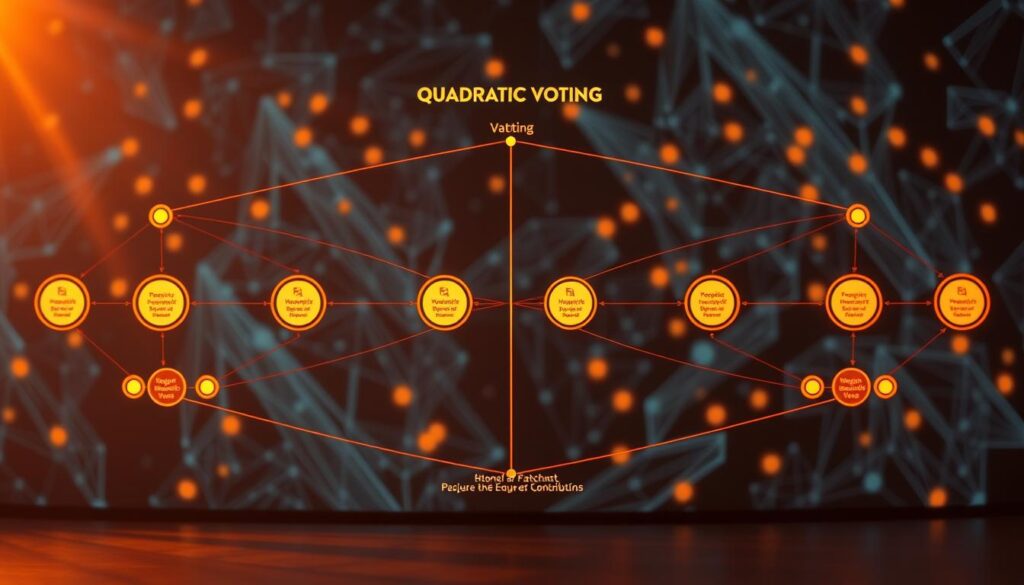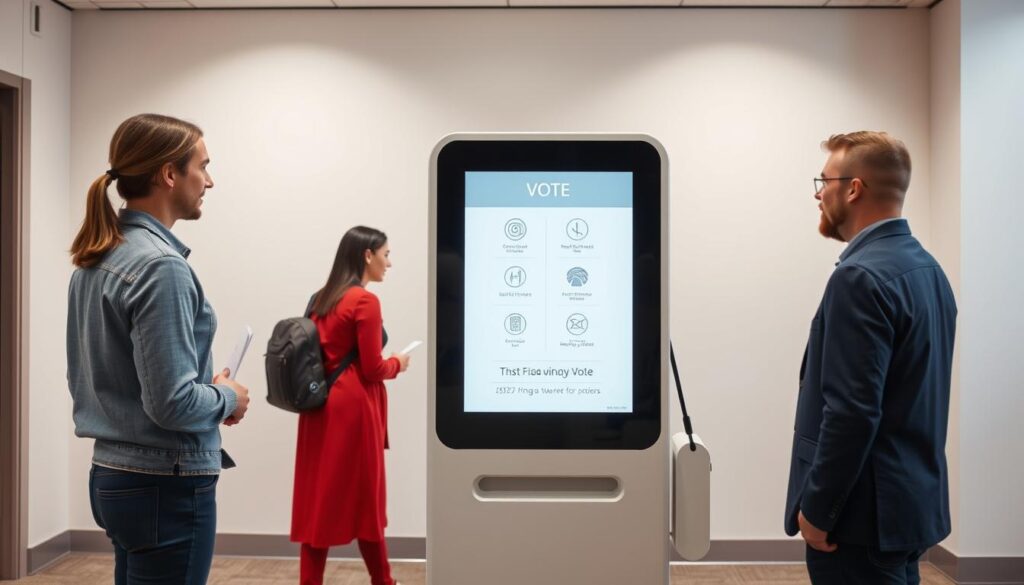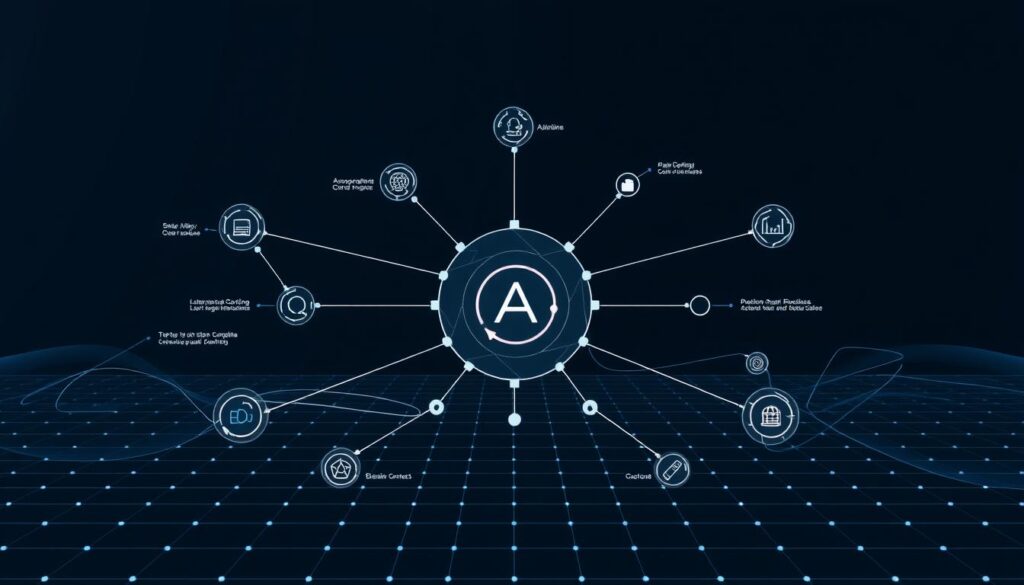Now Reading: Blockchain Governance: Models and Voting Systems Explored
- 01
Blockchain Governance: Models and Voting Systems Explored
Blockchain Governance: Models and Voting Systems Explored

Distributed networks thrive when participants agree on how decisions get made. At the core of every successful decentralized ecosystem lies a framework that balances transparency, security, and adaptability. These systems determine how protocol upgrades happen, resolve conflicts, and ensure networks evolve without centralized control.
Modern decentralized governance frameworks rely heavily on consensus mechanisms to align incentives among stakeholders. From miners to token holders, each participant’s influence often depends on their stake in the network. This approach prevents single entities from dominating critical choices about security parameters or feature implementations.
Recent innovations in voting systems now enable more nuanced decision-making. Quadratic voting and futarchy experiments allow communities to weigh preferences based on commitment levels rather than simple majority rules. Such methods aim to reduce manipulation risks while maintaining the integrity of protocol upgrades.
Key Takeaways
- Consensus mechanisms form the backbone of stakeholder alignment in decentralized systems
- Protocol upgrades require careful coordination to maintain network security
- Voting innovations address power imbalances in decision-making processes
- Token-based weighting systems influence participation levels
- Hybrid models combine on-chain execution with off-chain deliberation
Understanding Blockchain Governance Fundamentals
Unlike traditional corporate hierarchies, blockchain governance distributes authority across anonymous global participants through code-based rules and social coordination. This system relies on consensus algorithms to align incentives, creating permissionless networks where upgrades require broad agreement. Historical conflicts like Bitcoin’s block size debate and Ethereum’s DAO fork reveal how protocol changes test the balance between technical needs and community values.
Definition and Core Principles
Blockchain governance refers to the processes networks use to implement changes while maintaining decentralization. Its foundation rests on three pillars:
- Transparency in proposal tracking
- Inclusive participation mechanisms
- Enforceable protocol rules
Key Characteristics of Decentralized Decision-Making
True decentralization requires multiple stakeholder groups to validate changes. Governance tokens often determine voting power, but technical contributors still influence outcomes through code implementation. Networks achieve legitimacy when participants trust the system’s fairness more than individual actors.
Protocols establish baseline rules, but human actors interpret them during disputes. For example, Ethereum’s miners initially enforced chain splits before transitioning to validator-based governance. This tension between immutable code and adaptable social consensus defines most permissionless networks.
Stakeholder Roles in Governance Ecosystems
Power dynamics shift constantly between five key groups:
Developers vs Miners vs Token Holders
Developers propose technical upgrades, miners validate transactions, and token holders vote on proposals. Bitcoin’s 2017 SegWit conflict showed miners resisting developer-backed changes, while Ethereum’s shift to proof-of-stake prioritized token holder influence.
Institutional Investors and Community Members
Institutional holders often push for profit-driven changes, whereas community members focus on ideological purity. Recent DAO proposals reveal governance tokens concentrating power in whales’ hands, sparking debates about plutocracy in decentralized systems.
| Stakeholder | Primary Influence | Decision Power |
|---|---|---|
| Developers | Code implementation | High (technical control) |
| Miners/Validators | Network security | Medium (execution power) |
| Token Holders | Voting mechanisms | Variable (based on stake) |
| Institutions | Capital resources | Growing (through accumulation) |
| Community | Social consensus | Low (unless organized) |
On-Chain Governance Models
Blockchain networks are rewriting the rules of organizational management through on-chain governance models. These systems embed decision-making processes directly into protocol layers, enabling communities to upgrade networks without disruptive hard forks. Unlike traditional governance, these frameworks prioritize transparency and automation, creating a foundation for decentralized evolution.
Protocol-Level Decision Automation
At the core of on-chain governance lies the principle of code-is-law, where predefined rules execute upgrades automatically based on stakeholder input. Smart contracts serve as the backbone, processing votes and triggering protocol changes when consensus thresholds meet.
Smart Contract-Enabled Voting Mechanisms
Platforms like Tezos use blockchain voting systems powered by self-executing contracts. Token holders propose changes through formal submission processes, followed by multi-stage voting periods. This structure has facilitated 14 protocol amendments since 2018, demonstrating practical autonomous governance in action.
Tezos’ Self-Amending Blockchain Implementation
Tezos’ liquid proof-of-stake system enables stakeholders to delegate voting rights while maintaining asset liquidity. The network’s amendment processes include:
- Proposal submission requiring 5% stake endorsement
- 48-hour testing period for upgrade validation
- Final approval votes with 80% participation threshold
Advantages of Transparent Rule Enforcement
On-chain models eliminate ambiguity through mathematically verifiable decision records. Every proposal, vote, and outcome becomes permanently visible on the blockchain.
Real-Time Proposal Tracking Systems
Dashboards display live voting metrics, including:
- Stake-weighted approval percentages
- Geographic distribution of voters
- Historical comparison charts
This visibility builds trust while allowing participants to adjust strategies during active voting windows.
Reduced Human Intervention Requirements
Automated execution mechanisms minimize manual coordination efforts. Polkadot’s OpenGov system demonstrates this efficiency, processing 3x more proposals monthly than older governance models. However, critics highlight participation rates below 15% in some networks, suggesting room for incentive structure improvements.
While challenges persist, on-chain governance continues evolving through amendment process refinements and hybrid approaches. These models prove particularly effective for technical upgrades, though social coordination layers remain crucial for complex ecosystem decisions.
Off-Chain Governance Frameworks
Blockchain networks often rely on informal human-driven processes to manage upgrades and disputes. These off-chain systems prioritize community dialogue over automated protocols, creating flexible but sometimes unpredictable decision pathways.
Social Consensus Building Processes
Decentralized communities frequently use discussion platforms to align stakeholders. Bitcoin’s governance operates through a blend of technical debates and miner signaling, while Ethereum employs structured improvement proposals.
Bitcoin’s Mailing List Governance Approach
The BIP process demonstrates how Bitcoin’s developer maintainers coordinate changes without formal voting. SegWit’s activation (2015-2017) required years of mailing list discussions and miner support. This method prevented rushed decisions but exposed coordination gaps during the block size debate.
Ethereum Foundation’s Stewardship Model
Ethereum Improvement Proposals (EIPs) provide clearer structure, with core teams guiding major upgrades. Vitalik Buterin’s public statements significantly influence outcomes despite the network’s decentralized claims. The DAO fork reversal (2016) showcased both the speed and controversy of this approach.
Challenges in Informal Decision Structures
Off-chain systems struggle with scaling participation while maintaining security. As networks grow, achieving alignment across diverse stakeholders becomes increasingly complex.
Coordination Problems in Large Networks
Bitcoin’s soft fork coordination efforts during SegWit implementation revealed communication bottlenecks. Over 18 months, developers had to persuade miners, exchanges, and wallet providers through forums and conferences. These delays can create competitive advantages for chains with faster governance mechanisms.
Risk of Contentious Hard Forks
When consensus breaks down, communities face chain splits like Bitcoin Cash (2017). Ethereum Classic’s creation after the DAO reversal proves even established networks aren’t immune. Such events fragment communities and dilute network effects.
Hybrid Governance Systems
Blockchain projects are increasingly adopting blended governance to balance technical precision with human insight. These hybrid models merge automated protocols with community-driven processes, creating adaptable frameworks for decentralized decision-making. By combining on-chain efficiency and off-chain flexibility, they aim to address the limitations of purely algorithmic or social systems.
Combining Automated and Social Elements
Successful hybrid systems require careful alignment of cryptographic rules and stakeholder participation. The stakeholder voting process becomes critical in these models, ensuring both network security and community representation. Two pioneering implementations demonstrate distinct approaches to this balance.
Decred’s Parallel Voting Structure Analysis
Decred’s dual-layer governance uses Proof-of-Work mining and Proof-of-Stake voting to validate changes. Key features include:
- Miners propose protocol upgrades through blockchain transactions
- Stakeholders lock tokens to participate in final approval votes
- Mandatory 30-day voting periods for major changes
This structure achieved 76% voter participation in 2023, with 58% of proposals receiving approval. The system prevents unilateral control by requiring consensus across both technical and ownership layers.
Dash’s Budget Proposal Mechanism
Dash allocates 10% of block rewards to community-approved projects through its treasury system. Participants vote monthly using masternode operators as representatives. Recent data shows:
- 42% average voter turnout in 2023 (down from 61% in 2021)
- Only 33% of proposals received funding approval last quarter
- Increased competition for limited treasury funds
While effective for resource allocation, Dash’s model reveals challenges in maintaining long-term voter engagement compared to Decred’s hybrid consensus approach.
These contrasting systems highlight the importance of incentive design in decentralized governance. As seen in latest blockchain technology trends, successful hybrids must evolve to address participation fatigue while preserving security guarantees.
Token-Weighted Voting Mechanisms
Blockchain networks increasingly tie decision-making power to token ownership, creating systems where governance influence mirrors financial stake. This approach balances accountability with economic incentives but raises critical questions about fairness and participation. Let’s explore how these mechanisms function and where they succeed or falter.
Proof-of-Stake Influence Distribution
In proof-of-stake networks, voting power typically scales with the number of tokens staked. The Cosmos Hub demonstrates this model’s potential, with 42% average voter participation across governance proposals. However, Flipside Crypto data reveals most PoS chains struggle to reach 15% turnout, highlighting systemic engagement gaps.
Cosmos Hub’s Governance Participation Rates
Cosmos achieves higher engagement through built-in proposal deposits and clear upgrade incentives. Validators automatically vote unless they actively opt out, creating baseline participation. Yet even this system sees 60% of proposals decided by fewer than 10 large stakeholders, according to recent chain analytics.
Wealth Concentration Risks
Pure token-weighted systems risk creating plutocracies. A single whale holding 15% of circulating tokens can sway decisions in smaller networks. Projects like Osmosis counter this with time-locked voting – users gain extra weight by committing tokens for longer periods. This approach rewards long-term alignment over short-term speculation.
Delegated Voting Solutions
Many chains allow token holders to delegate voting rights, theoretically combining expertise with broad participation. The Binance Smart Chain implements this through 21 elected validators who represent smaller stakeholders. While efficient, critics argue this creates validator cartels controlling network upgrades.
Binance Smart Chain Validator System
BSC’s structure enables rapid decisions but centralizes power – the top five validators control 68% of voting power. Recent proposals to expand the validator set face resistance from existing players, illustrating how delegated systems can entrench power structures rather than democratize them.
Voter Apathy Challenges
Even sophisticated delegation mechanisms battle low engagement. Less than 9% of eligible voters participate in most governance proposals across major chains. Emerging solutions include:
- Staking derivatives that let users vote without unstaking assets
- Quadratic voting models (covered in Section 7) to balance whale influence
- Automated delegation tools matching users with aligned validators
Platforms experimenting with vote delegation bonuses report 3x higher participation rates, suggesting economic incentives could overcome apathy. However, these systems require careful design to avoid simply rewarding existing large holders.
Quadratic Voting Implementations
Blockchain communities are testing quadratic voting to address power imbalances in decentralized governance. This system assigns voting power based on the square root of token holdings, creating a mathematical check against concentrated influence. Early adopters report measurable success in amplifying diverse voices while maintaining stakeholder accountability.

Balancing Small and Large Holders’ Influence
Quadratic voting’s core innovation lies in its cost curve structure. Casting multiple votes for a single proposal becomes exponentially more expensive, discouraging whale dominance. The model mathematically favors participants spreading votes across multiple initiatives rather than concentrating on personal agendas.
Gitcoin’s Matching Fund Experiments
Gitcoin’s GR15 funding round demonstrated quadratic voting’s potential, with small donations increasing 47% compared to traditional models. Community members allocated $4 million through this system, prioritizing grassroots projects over corporate proposals. The platform’s quadratic funding mechanics created unique incentives – contributors maximized impact by supporting undervalued initiatives rather than popular trends.
Sybil Attack Prevention Measures
Identity verification remains the critical challenge for quadratic systems. BrightID’s facial recognition solution achieves 78% authentication success rates, while proof-of-humanity protocols add blockchain-based verification layers. Current solutions combine three key elements:
- Biometric validation through live video sessions
- Social graph analysis to detect fake networks
- Continuous activity monitoring post-registration
These safeguards enable platforms to maintain democratic voting integrity while blocking duplicate accounts. However, technical barriers persist – 22% of legitimate users still face authentication hurdles in current systems. Ongoing improvements focus on balancing security with accessibility to preserve quadratic voting’s egalitarian ideals.
Futarchy Prediction Market Models
Blockchain communities are testing a radical governance method where prediction markets determine protocol changes. This approach, called futarchy, lets traders bet on outcomes to guide decisions. While promising in theory, real-world applications face significant liquidity and participation hurdles.
Market-Based Decision Validation
Futarchy converts governance proposals into tradable assets. Traders buy shares representing “yes” or “no” outcomes, creating financial incentives for accurate predictions. The system assumes markets aggregate information better than traditional voting methods.
Augur’s Governance Market Prototypes
Augur’s 2021 experiment revealed critical challenges. Despite advanced oracle technology, governance markets saw less than $50k daily volume. Key issues included:
- Complex user interfaces for non-traders
- Lack of clear incentives for token holders
- Uncertain regulatory status
Liquidity Requirements for Effective Implementation
Academic models suggest prediction markets need $2M+ liquidity to resist manipulation. Current decentralized exchanges rarely sustain these levels for governance-related assets. This table shows the gap between theory and practice:
| Parameter | Academic Model | Real-World DEX |
|---|---|---|
| Minimum Liquidity | $2.1M | $480k |
| Active Participants | 850+ | 120-300 |
| Price Impact Threshold | <2% | 8-15% |
These gaps create vulnerabilities. A single whale could sway market prices with modest investments, undermining decision integrity. Developers now explore hybrid models combining governance tokens with staking mechanisms to boost participation.
Reputation-Based Governance Systems
Blockchain networks are experimenting with reputation-based systems to reward consistent participation beyond financial stakes. These models prioritize community contributions through measurable actions, creating meritocratic governance structures where influence matches demonstrated commitment. Unlike token-weighted voting, these systems use non-transferable tokens tied to user activity to prevent power concentration.

Non-Financial Participation Incentives
Reputation frameworks incentivize users through contributor scores that reflect their value to the ecosystem. DAOstack’s design stands out with a 63% annual reputation decay rate for inactive members, ensuring only engaged participants retain decision-making power. This approach combats voter apathy while rewarding those who consistently propose or review initiatives.
DAOstack’s Reputation Token Design
DAOstack’s algorithm automatically adjusts reputation scores based on:
- Proposal submission frequency
- Community voting accuracy
- Collaboration with other contributors
The platform’s steep decay rate creates natural turnover, with 41% of inactive users losing voting rights within six months. This mechanism maintains network agility but risks alienating occasional contributors.
Long-Term Contributor Recognition Models
Yearn Finance’s Coordinape system takes a different approach, using peer-nominated rewards to identify valuable contributors. Key outcomes from their 2023 implementation include:
| Metric | DAOstack | Yearn Coordinape |
|---|---|---|
| Developer Retention | 68% (6-month) | 82% (6-month) |
| Proposal Quality Score | 4.1/5 | 4.6/5 |
| New Contributor Growth | +29% quarterly | +53% quarterly |
Yearn’s model demonstrates how social recognition complements automated systems. Their quarterly “contribution circles” allow teams to allocate reputation points through consensus, fostering stronger community bonds than purely algorithmic approaches.
Bitcoin’s Governance Evolution
Bitcoin’s decentralized governance framework has transformed dramatically since its 2009 launch, evolving from Satoshi Nakamoto’s singular oversight to a complex ecosystem of developers, miners, and institutional stakeholders. This evolution reveals critical tensions between protocol preservation and technological progress, particularly as new players reshape decision-making dynamics.
Pioneering Consensus Building
Early Bitcoin governance relied heavily on technical meritocracy, with core developers driving protocol changes through Bitcoin Improvement Proposals (BIPs). Two landmark events illustrate this evolution:
SegWit Activation Timeline Analysis
The 2017 Segregated Witness upgrade demonstrated Bitcoin’s governance challenges. After three years of debate, the User-Activated Soft Fork (UASF) movement forced activation through node operator consensus, bypassing reluctant mining pools. This marked the first major instance of non-miner stakeholders overriding miner preferences.
Miner Signaling Mechanisms
Mining pools historically influenced upgrades through hash-power voting. However, Fidelity’s 2023 entry into Bitcoin mining introduced new corporate incentives, with institutional players now controlling 37% of network hash rate according to Blockchain.com data. This shift complicates traditional mining pool dynamics in governance decisions.
Modern Governance Complexities
Current Bitcoin governance faces unprecedented challenges as competing factions advocate for different scaling solutions:
Developer Maintainer Dynamics
The Bitcoin Core development team maintains significant influence through code maintenance privileges. Recent debates over drivechain implementations and BitVM rollouts highlight growing tensions between protocol purists and innovators pushing for enhanced smart contract capabilities.
Institutional Investor Influence Growth
Corporate Bitcoin holders now control 6.3% of circulating supply (Glassnode 2024), creating new pressure points in governance. These entities increasingly lobby for changes like taproot adoption optimizations to improve transaction privacy for institutional-scale operations.
As Bitcoin approaches its next halving event, stakeholders continue wrestling with fundamental questions about upgrade authority and protocol sovereignty. The network’s ability to balance these competing interests will determine its capacity to evolve while maintaining decentralized principles.
Ethereum’s Transition to Proof-of-Stake Governance
Ethereum’s Proof-of-Stake overhaul introduces new dynamics in validator influence and upgrade coordination. The network’s 2022 Merge event replaced energy-intensive mining with staker-driven validation, creating a governance model where participants’ voting power correlates with their economic stake. This shift addresses scalability concerns while raising fresh questions about power distribution and decision-making efficiency.

Validator Committee Structures
The Ethereum network requires validators to stake 32 ETH to participate directly, though most users join through staking pools. These pools aggregate resources but create centralization risks – Lido Finance alone controls 32% of staked ETH. Key considerations include:
Staking Pool Centralization Concerns
Concentration in major pools triggers validator queue bottlenecks and protocol risks. If three large providers coordinate, they could theoretically delay transactions or censor specific addresses. The network combats this through:
- Slashing conditions penalizing malicious behavior
- Dynamic validator rotation schedules
- Decentralized client software requirements
MEV (Miner Extractable Value) Implications
Validators now capture MEV profits previously earned by miners. While specialized software helps distribute these gains fairly, concerns persist about:
- Front-running transactions for profit
- Exclusive MEV tools favoring large validators
- Network latency advantages for centralized pools
Upgrade Decision Processes
Ethereum’s governance combines technical proposals with community signaling. The Ethereum Improvement Proposal (EIP) lifecycle follows five stages:
- Idea incubation in developer forums
- Technical specification drafting
- Testnet implementation trials
- Mainnet deployment voting
- Post-upgrade monitoring
EIP-1559 Implementation Case Study
The controversial 2021 fee market overhaul demonstrated Ethereum’s upgrade mechanics. Despite initial miner opposition, the change achieved:
| Metric | Pre-EIP-1559 | Post-EIP-1559 |
|---|---|---|
| Average Fee Predictability | Low | High |
| ETH Burn Rate | 0% | 2.5 ETH/minute |
| Network Congestion | Frequent | Reduced 68% |
Shanghai Upgrade Coordination
The 2023 Shanghai hard fork achieved 98.7% validator approval through:
- Six-month testing across four testnets
- Automated upgrade tracking tools
- Staggered validator queue activation
This contrasts sharply with Bitcoin’s multi-year SegWit debates, showcasing PoS systems’ coordination advantages when economic incentives align.
Tezos’ On-Chain Amendment Process
Tezos stands out in blockchain governance through its self-amendment protocol, enabling seamless upgrades without hard forks. The network has executed 14 protocol changes since 2018 using a structured 23-day voting cycle, demonstrating practical implementation of on-chain decision-making.
Building Trust Through Code Verification
Every upgrade proposal must pass rigorous checks using Tezos’ Michelson language, designed specifically for smart contract safety. This approach ensures:
- Mathematical proof of code correctness
- Automatic rejection of unsafe proposals
- Reduced human error in critical changes
Protocol Upgrade Voting Timeline
The amendment process follows four phases:
- Proposal period (5 days)
- Exploration vote (2 days)
- Testing period (48 hours)
- Promotion vote (final 48 hours)
Baking Node Participation Rates
| Year | Participation Rate | Delegated Stakes |
|---|---|---|
| 2019 | 81% | 62% |
| 2021 | 67% | 74% |
| 2023 | 54% | 83% |
Measuring Progress and Challenges
While Tezos completes upgrades faster than most chains (average 32 days per amendment), participation trends reveal emerging concerns.
Number of Successful Protocol Upgrades
The network averages 2.8 upgrades annually, with 93% success rate for proposals reaching final voting. Recent changes improved transaction speeds by 150% and reduced gas fees by 40%.
Voter Turnout Trends Since Launch
Despite increased delegation options through liquid voting mechanisms, active participation dropped 33% since 2019. Analysts suggest:
- Voter fatigue from frequent proposals
- Complexity in evaluating technical upgrades
- Concentration of voting power among large bakers
Tezos’ Michelson language requirements create high security standards but also slow community-led initiatives. The system balances automated checks with human input, though rising abstention rates question long-term decentralization goals.
Emerging Governance Innovation Trends
Blockchain governance is entering a new phase where AI-driven tools and cross-chain coordination redefine how communities make decisions. These innovations address critical challenges in scalability, security, and stakeholder participation while introducing novel approaches to decentralized leadership.
AI-Assisted Proposal Analysis Tools
Decentralized organizations now deploy machine learning systems to process governance proposals at unprecedented speeds. OpenZeppelin’s Defender 2.0 platform demonstrates this shift, using automated code audits to reduce smart contract vulnerabilities by 38% in recent DAO proposals.
Natural Language Processing for DAO Governance
Advanced NLP algorithms analyze proposal sentiment and detect contradictory clauses in real time. These AI moderators flag high-risk motions before voting begins, helping communities avoid costly mistakes like the 2023 Euler Finance governance exploit.
Automated Code Audit Implementations
Smart contract review tools now integrate with governance platforms through APIs. Key features include:
- Automatic vulnerability scoring for proposed code changes
- Simulated attack vectors for upgrade proposals
- Historical risk comparisons across similar DAOs
Cross-Chain Governance Protocols
New interoperability standards enable coordinated decision-making across multiple blockchain networks. This governance automation breakthrough allows communities to manage assets and rulesets spanning different ecosystems simultaneously.
Polkadot’s Shared Security Model
Polkadot’s Gov2 system shows both promise and challenges, with 4.2% of active addresses participating in cross-parachain governance. Its relay chain architecture enables:
| Feature | Impact |
|---|---|
| Collective Security Pool | 63% faster dispute resolution |
| Multi-chain Voting | 41% increase in proposal turnout |
LayerZero’s Omnichain Governance Experiments
Using cross-chain messaging, LayerZero enables DAOs to execute decisions across 12+ networks through single proposals. Early adopters report 78% faster fund transfers between Ethereum and Avalanche governance treasuries compared to bridge solutions.
These innovations create new possibilities for blockchain communities while raising questions about technical complexity. As AI moderators become standard and cross-chain systems mature, governance models must balance automation with human oversight to maintain decentralization principles.
Scalability Challenges in Decentralized Governance
As blockchain networks grow, their governance systems face a critical test: maintaining efficiency while handling increased activity. The push for faster decisions often clashes with technical limitations, creating unique hurdles for decentralized communities.
Network Congestion During Voting Periods
High-demand voting events frequently overwhelm blockchain networks. Solana’s 2022 governance failure during a network outage highlights this issue – its 65,000 transactions-per-second architecture still couldn’t process votes when validators disconnected. This incident exposed three key problems:
- Time-sensitive proposals becoming invalid during downtime
- Voter exclusion due to temporary network partitions
- Increased voting gas costs during peak activity
Solana’s High-Frequency Voting Limitations
The network’s 400ms block time creates unique challenges. While fast for trading, this speed complicates governance processes requiring human deliberation. Validators often struggle to assess proposals between blocks, leading to rushed decisions.
Layer 2 Voting Aggregation Solutions
New scaling approaches aim to reduce mainnet strain. Arbitrum’s Orbit chains enable communities to conduct polls on private networks before submitting final results. Polygon’s zkEVM uses zk-SNARK voting proofs to batch thousands of votes into single transactions, cutting gas fees by 90% in recent tests.
Security vs Participation Tradeoffs
Blockchain teams face difficult choices when optimizing governance systems. Faster finality times often require centralization, while broader participation slows decision-making.
Finality Time Impacts on Governance
Networks with instant settlement like Solana risk optimistic governance errors – malicious proposals could execute before thorough review. Ethereum’s 15-minute finality window allows more scrutiny but delays urgent upgrades.
Validator Set Size Optimization
Expanding validator numbers improves decentralization but creates coordination challenges. Avalanche’s solution uses randomly selected subcommittees of 100 validators, achieving both speed and security. However, this approach requires advanced zk-SNARK voting systems to prevent manipulation.
Emerging solutions balance these competing needs. NEAR Protocol’s sharded governance splits voting across parallel chains, while Cosmos’ interchain accounts enable cross-network participation without overwhelming individual chains.
The Future of Blockchain Governance Models and Voting Systems
Blockchain governance continues evolving as decentralized autonomous organizations test novel frameworks for collective decision-making. Projects like MolochDAO demonstrate how ragequit mechanisms enable participants to exit unfavorable decisions while preserving network integrity. These experiments highlight the growing demand for systems balancing flexibility with accountability.
Adaptive quorum models are gaining traction as tools to maintain operational efficiency during network stress. Platforms such as Balancer implement veTokenomics to align long-term stakeholder incentives with protocol health. This approach ties voting power to commitment duration, creating dynamic participation structures responsive to ecosystem needs.
Regulatory developments like Europe’s MiCA legislation will shape governance mechanisms across public blockchains. Compliance requirements may drive adoption of identity-linked voting layers while preserving pseudonymous participation options. Such hybrid models could reconcile regulatory demands with blockchain’s core principles.
Quantum-resistant voting protocols are emerging as critical infrastructure upgrades. Projects exploring lattice-based cryptography aim to future-proof governance systems against advanced computational threats. These security enhancements complement AI-driven analytics tools that help communities evaluate complex proposal impacts.
The next generation of governance frameworks will likely combine automated enforcement with human oversight. As prediction markets and reputation systems mature, decentralized networks could implement multi-layered validation processes. Successful models will prioritize adaptability, ensuring blockchain ecosystems remain resilient amid technological and regulatory shifts.















